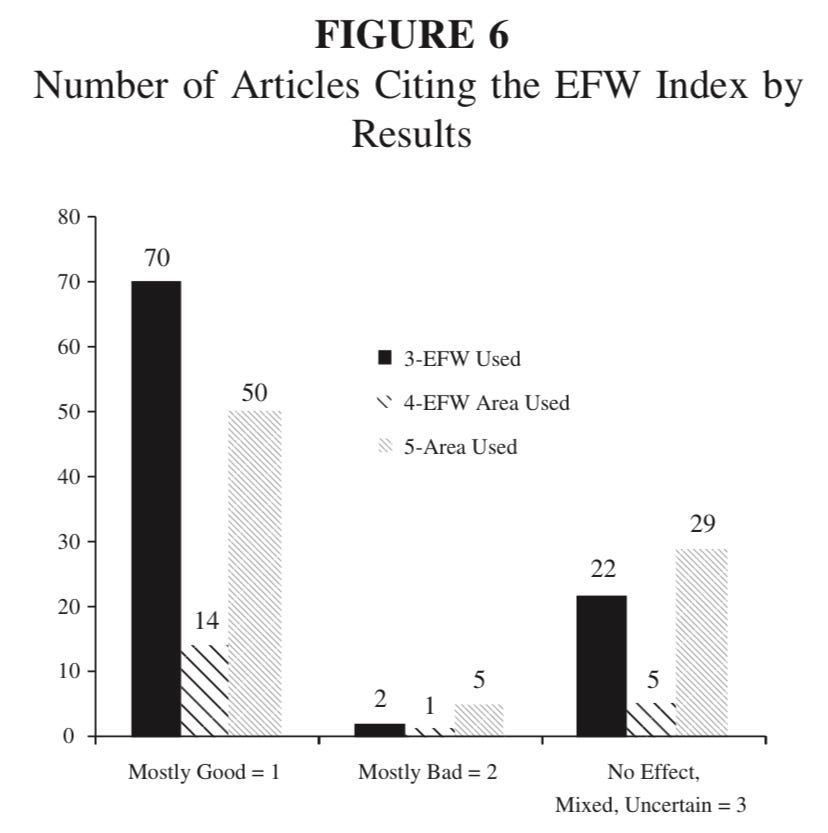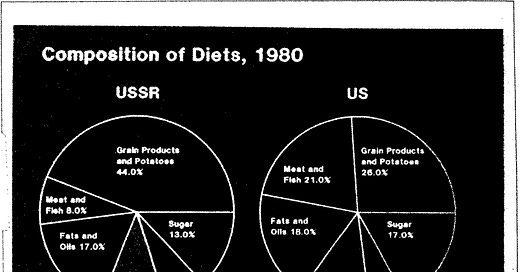

Discover more from That Great Fiction
No, Socialism Does Not Provide Better Quality of Life
A rebuttal to the infamous Ceresrto and Waitzkin paper.
No matter what side of the political spectrum you are on, if you have ever been in an argument with a socialist, you have almost undoubtedly come across the claim that economic development and quality of life have been statistically better in socialist countries. Many of these ideas and claims come from a 1986 paper, Capitalism, socialism, and the physical quality of life, written by Shirley Ceresrto and Howard Waitzkin. In my critique of this paper, my goal is to put its protestations to the test through counterfactuals.
The paper looks at over 100 countries and divides them into various groups based on their economic system and control for economic development.
Economic development is measured using the gross national product per capita (GNP/c).
The economic system is split into centrally planned (socialist) and market (capitalist) using The United Nations’ classifications.
The outcomes compared among these countries include:
“(1) indicators of health, health services, demographic conditions, and nutrition (infant mortality rate, child death rate, life expectancy, crude death rate, crude birth rate, population per physician, population per nursing person, and daily per capita calorie supply); (2) measures of education (adult literacy rate, enrollment in secondary education, and enrollment in higher education); and (3) a composite PQL index.”
The authors conclude:
“The data indicated that the socialist countries generally have achieved better PQL outcomes than the capitalist countries at equivalent levels of economic development.”
These results appear contrary to the fact that in a centrally planned economy economic calculation is impossible. With the abolition of private property and the exchange of the factors of production, price signals can no longer show producers where resources are more efficiently and rationally allocated.
When an item costs $50 to produce and can only be sold for $5, then it’s clear the final product is less valuable to consumers than the materials themselves. With no such signals, central planners are shooting shots in the dark.
If socialist economies are incapable of producing better outcomes, why does the data show otherwise?
composite PQL index:
Contrary to the claims socialists make, capitalist countries do perform at the top. However, since these countries are “High-income” they apparently don’t count. The way in which countries are compared using “economic development” ensures that The United Kingdom, Japan, Austria, Finland, Australia, Canada, Netherlands, Belgium, France, United States, Denmark, West Germany, Norway, Sweden, and Switzerland are not compared to countries like The USSR, Cuba, and China, appearing to be a case of sample selection bias.
Controlling variables in a study is certainly a no-brainer, but should economic development be the sole variable in a study about which economic system is superior?
No socialist countries in the study achieved the “High-income” category, and the capitalist countries, in that category, overall outperform every socialist competitor.
This evidence appears to be more than sufficient evidence that capitalism outperforms socialism.
What Is Socialism?
Why do socialist countries seem to outperform capitalist ones at the “same level of economic development”? One reason is because of the definitions used. somewhat controversial terms to define. Many socialists will claim that any system in which commodities are sold for a profit is capitalist, whereas some argue a “market socialist” economy is possible.
So, which definition should we use? I believe this question was answered in 1988 by economist Hans-Hermann Hoppe in his work A Theory Of Socialism and Capitalism:
“...socialism, by no means an invention of nineteenth-century Marxism but much older, must be conceptualized as an institutionalized interference with or aggression against private property and private property claims. Capitalism, on the other hand, is a social system based on the explicit recognition of private property and of nonaggressive, contractual exchanges between private property owners. Implied in this remark, as will become clear in the course of this treatise, is the belief that there must then exist varying types and degrees of socialism and capitalism, i.e., varying degrees to which private property rights are respected or ignored. Societies are not simply capitalist or socialist. Indeed, all existing societies are socialist to some extent.”
This interpretation of socialism and capitalism seems to be the most rational. After all, socialists always advocate for further restrictions and public control over private property.
The most important takeaway from this definition is the “varying degrees” of socialism and capitalism. Many left-wingers proclaim the Scandinavian countries as successes of socialism, despite these countries being built off of markets and private property rights. If we can separate the socialist welfare policies from the capitalist private property, it becomes much easier to have a reasonable discussion on which economic model is superior. If I built a house completely entirely out of bricks, save one wall composed of straw, is it a brick house or a straw house? If the house stays up, can I credit the straw for being the reason? If the house falls, can I blame it on the bricks? This analogy raises very important questions when considering the conclusion of the PQL paper.
To demonstrate, this let’s take a look at Syria (a country labeled as “capitalist” in the PQL paper) through the book Syria: A Country Study:
“By 1986 the situation remained essentially unchanged. As a result of these earlier measures, the government dominated the economy—accounting for three−fifths of GDP—and exerted considerable influence over the private sector”
Is it fair to label a country as a capitalist failure when the private sector accounts for less than half of the economy? Some socialists might point out Syria's mild economic liberalization reforms in the 70s, however, this is a non sequitur since even after the reforms, the government-controlled a majority of the economy. Syria in the 80s was certainly not a capitalist economy.
Another country the PQL paper proudly labeled as “capitalist” was Burma (now called Myanmar or Old Burma), which was quite shocking to me since I’ve been to Myanmar and was aware of the country’s socialist history while I was there.
From 1962 to 1988 Myanmar was under a plan called the Burmese Way to Socialism. In February 1963, the Enterprise Nationalization Law was degreed. All major industries were nationalized, including Oil, Banks, newspapers, and more. Over 15,000 private firms were nationalized, and Myanmar became a Soviet-style planned economy.
These two examples show that the economic classifications used are almost complete nonsense. Of course, some of these countries may still be labeled correctly, but there is evidence that these labels should not be taken at face value.
Unfair Comparisons
In the “low-income” category 33 capitalist countries are included along with only 1 socialist country (China).
The capitalist countries have quite a wide range of GNP/c, $80-$530. Socialist China comes in at $300.
“Recent postrevolutionary” is also a category, although these countries are excluded from the “socialist” sample. These exclusions make sense until you consider the full context. Postrevolutionary countries are deemed to not have been socialist for long enough to actually be included in the socialist dataset. This same standard is never applied to capitalist countries.
Afghanistan is one of the countries included under “postrevolutionary”. Afghanistan was in the middle of the ravaging Soviet-Afghan war, which would have skewed the data away from the socialists’ favor. However, Chad is still included as a capitalist country despite it being in the midst of the Chadian–Libyan conflict (a conflict that can be blamed on socialism and the Soviet Union).
When formulating an empirical conclusion on which economic system is superior, we need far more controls than this. Many factors such as geography, religion, war, etc… can affect economic growth and physical well-being.
In the PQL paper, almost every country under the capitalist category is located in Africa, while almost none of the socialist countries are from the continent. Africa not only has some of the more harsh geographies but this historical period was filled with war and conflicts. The Lebanon War, the 1982 Kenyan coup d'état attempt, the 1982 Central African Republic coup d'état attempt, and the Ethiopian–Somali Border War just to name a few.
Geography is often overlooked as a major factor in economic development. A majority of these “capitalist” countries in Africa or the Middle East are landlocked, while China has 9,010 miles of coastline.
Gallup et al. (1998) suggest that location and climate, through their impacts on transportation costs, the burden of disease, and agricultural productivity, have significant effects on development.
And according to the United Nations:
“Overall, the level of development in LLDCs (Landlocked Developing Countries) is about 20 percent lower than it would be were they not landlocked. The economies of LLDCs are generally characterized by dependence on a limited number of commodities and minerals, a large informal sector, weak social capacities, high unemployment and low productivity. Furthermore, LLDCs manifest a high trade concentration ratio compared to other groups of countries, meaning their exports are highly concentrated in a limited number of products.”
In 2018 three researchers published a paper titled, Deep cultural ancestry and human development indicators across nation states. The purpose of this paper was to explore how historical connections, events, and cultural proximity affected human development.
The paper examined 44 Eurasian countries, using language ancestry as a proxy for cultural relatedness and controlling for geographical proximity, religion, and former communism. Using a greater array of controls means they were more likely to see the true effects of a particular variable than if they were making surface-level observations and correlations.
The authors point out,
“Geography and the associated environmental variation has often been cited as a factor that may limit or impede development. For example, the problems posed by lack of waterways for inland, continental areas], and the difficulties of the tropical climate have been cited as reasons why certain areas have had low levels of human development.”
The Counter-Evidence
The authors go on to discuss communism,
“Communism significantly negatively predicts HDI, income and health indices” and… “These results support a significant effect of communist history on the human development of countries, comparable to the effects of geography (which remains a significant predictor of HDI and income index), and more immediately important than cultural phylogeny or religion.”
These results from a more methodological sound study give us a much different story than the commonly cited PQL paper.
Earlier I pointed out that countries can be varying degrees of capitalist or socialist. Using this fact, many researchers have attempted to measure the degree to which countries are capitalist and how that degree correlates with positive economic and physical outcomes.
In 2013, a paper by economists Joshua C. Hall and Robert A. Lawson examined over 400 academic papers which utilized the Fraser Economic Freedom of The World Index (EFW) and examined its effect on various measures of quality of life.
What is the EFW index exactly? The author’s answer:
“The EFW index is designed to measure the consistency of a nation’s policies and institutions with economic freedom. The EFW index places the concept of economic freedom within the classical liberal tradition that emphasizes the importance of private property, rule of law, free trade, sound money, and a limited role for government. Higher scores are accorded to nations with more secure property, freer trade, more stable money and prices, less government spending, and fewer regulations.”
This method of measuring the degree to which a country is capitalist wields astounding results:
“Over two-thirds of these studies found economic freedom to correspond to a ‘good’ outcome such as faster growth, better living standards, more happiness, etc. Less than 4% of the sample found economic freedom to be associated with a ‘bad’ outcome such as increased income inequality. The balance of evidence is overwhelming that economic freedom corresponds with a wide variety of positive outcomes with almost no negative tradeoffs.”
Conclusion
Ceresrto and Waitzkin’s 1986 paper fails to provide sufficient proof that a socialist economic system is superior to a capitalist one, in terms of physical quality of life. Research that covers the degree to which a country is socialist is far better methodologically and tends to overwhelmingly favor capitalism, and is therefore completely consistent with the predictions made by free market theorists and economists for hundreds of years.
Subscribe to That Great Fiction
Economics, Politics, and Society. Takes and analysis inspired by the works of the Austro-Libertarians like Hans-Hermann Hoppe
















You completely strawman the argument of Waitzkin and Cererto concerning the sample selection used in their study. You cannot compare countries like the UK, France, the U.S, and Belgium, countries that have benefitted from centuries of capital accumulation through colonialism and decades of capital accumulation from neocolonialism to countries in the Global South that were previously neo-colonies or colonies of the Western countries you just mentioned. That is the reason for the sample sizes used in the study, not "sample selection bias" as you claim.
And most of all: 30 years later, let's redo the analysis and i am sûre the results will be different